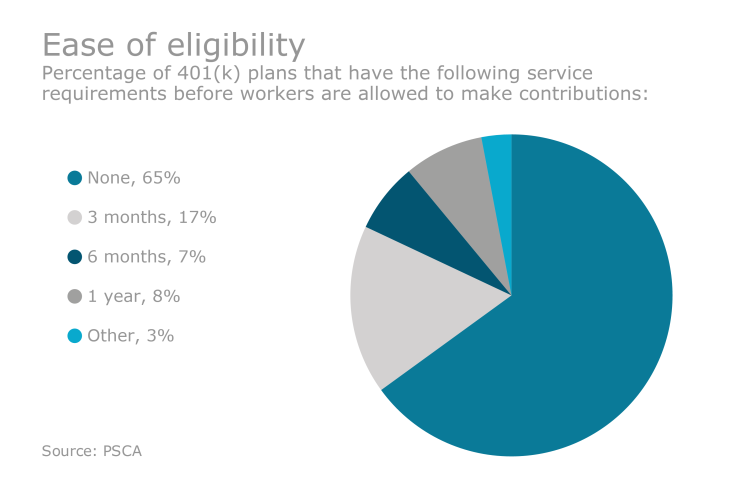A passive investment management approach is appropriate for many 401(k) plan participants. But
Those are only a few of the reasons for employers to consider active investment management for their employees. Listed below are a number of others, followed by suggestions on how to make active management work in 401(k) plans.

Normal correlations. Correlation is how different asset classes and securities move up or down in relation to each other. When all risk assets are highly correlated, it’s hard for active managers to distinguish themselves. During times of extreme market turbulence, similar to the 2008-09 period, all securities tended to move in the same direction and with the same relative magnitude. During non-crisis periods, better stocks will typically outperform averages, reflecting their better earnings prospects. As a result, investment managers who are talented stock pickers will outperform.
Managers can exit from falling markets quickly. Probably the most important component of active management is that there is a manager who can sell out of a falling market to avoid capturing 100% of a down market move. Remember that the number one rule in investment management is “Don't lose my money!”
Average index performance in every market. Index investors capture 100% of every market crash. Don’t like being assured of capturing all of the next equity market free-fall? Keep in mind that your gains when the market turns will also be limited by your index fund as well. Index investments have no ability to outperform and always provide average returns.
Not all investment advisers are conflicted. Many brokers, as well as insurance company and bank advisers, are required by their employers to offer proprietary products first. These advisers are not objective and give active management a bad name. You don’t have to work with them. There are many independent, objective investment
Markets are inefficient. Good portfolio managers exploit the inefficiencies inherent in markets. During every crash the market oversells because the world is coming to an end this time for sure. In every bull market buyers get carried away with irrational exuberance and push securities well beyond what they are worth. Taking advantage of these inefficiencies is one way good portfolio managers make money for their clients.
Animal spirits rule. We live in America, where entrepreneurship and innovation are valued and rewarded. Most of our brains are not calibrated to be satisfied with average or index returns. We expect to have above-average children, above-average pay raises and above-average returns in our investment portfolios. Index investing guarantees average returns every year. I talk with very few investors who are happy with average returns. Many feel that if they experience a year of average returns, it was not a good year.
How to use active management in your 401(k) plan
Eliminate closet indexers. Purge closet indexers from your 401(k) plan. They never significantly beat their benchmarks and give active management a bad name. This is where excess cost resides in your 401(k). How do you
Index efficient asset classes. Invest in index funds in those asset classes that are efficient — where it is hard for a mutual fund manager to significantly and consistently beat the benchmark. A nice listing of efficient and inefficient asset classes may be found
Use active management for inefficient asset classes. Inefficient asset classes are those in which a skillful fund manager can generate positive alpha (excess returns above the benchmark) by identifying some criteria that the market is not efficiently pricing into the asset class or security. Examples of these
Remember that defense is good. Consider that some active managers are really good defenders of your investment. Their funds may not outperform significantly in up markets but may fall much less than market indexes in down markets. Choose to invest in actively managed mutual funds in inefficient asset classes that have down market capture rates of less than 100%.
Review a full market cycle. A major reason many investors abandon active management is they feel every actively managed fund should beat its benchmark every quarter. This is unrealistic and silly. First, can you think of an industry where 100% of the businesses are above average? Every quarter? Neither can I.
Yes, there are a number of active managers who are below average, in other words, they don’t outperform their index very often. You do not need to place your money with them. There are more than enough active managers that outperform their benchmarks in every asset class. One way of identifying who they are is to review the performance of any mutual fund you are thinking of investing in over a full market cycle. Full market cycles generally last at least five years. This will help you find those managers who do a good job protecting your investments when markets decline.
According to WalletHub research, these places rank low in affordability, quality of life and healthcare.
Use active management to allocate. Talk with the investment adviser who works with your 401(k) plan. He/she can help you measure your risk tolerance so that you can allocate correctly between stocks and bonds. Using your risk tolerance level (aggressive, moderate, conservative) along with your age, your advisor can suggest appropriate allocations for your 401(k) account.
Be aware of the problems with index investing. John Bogle, of Vanguard fame, has pointed out that as indexing progresses it creates opportunities for active investors. In fact, according to
The
To be fair, none of these problems appears on the horizon at the moment. However, as the popularity of indexing increases, so do the odds of these scenarios occurring. Markets always tend to overdo it. And we Americans always feel as if we can never get too much of a good thing. However, with index investing it appears that more will not always be better.
Whether you are evaluating investment options for your 401(k) plan lineup, or choosing how to allocate your 401(k) balance, most investors’ portfolios are optimized when a






